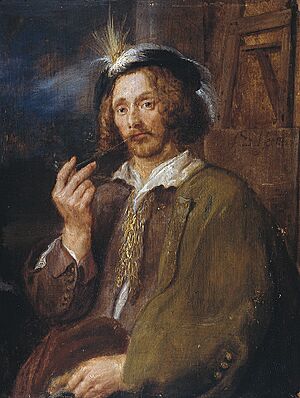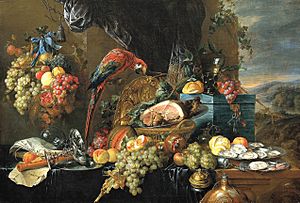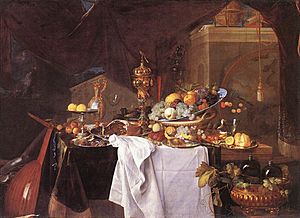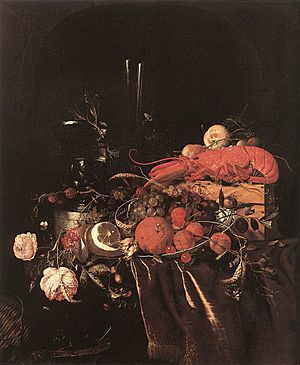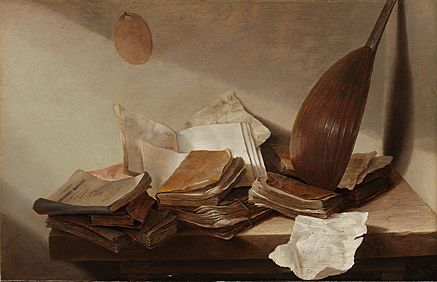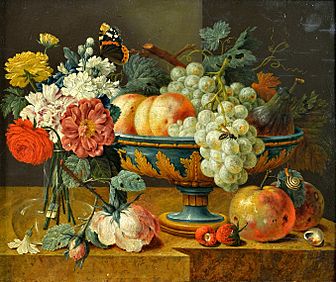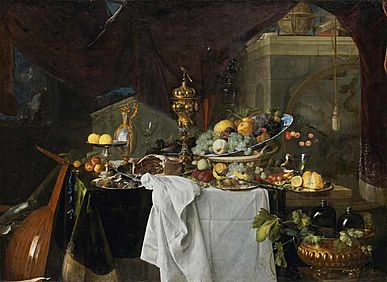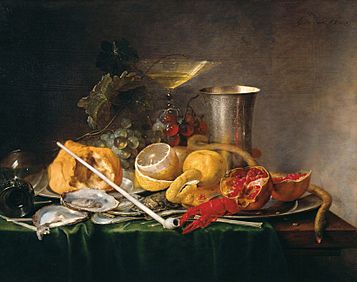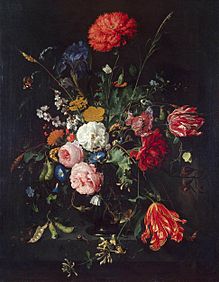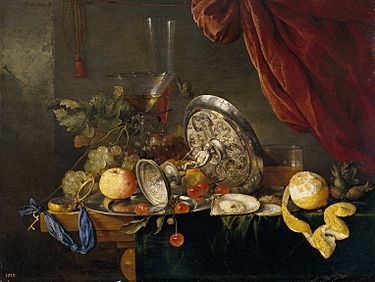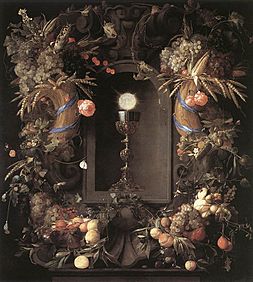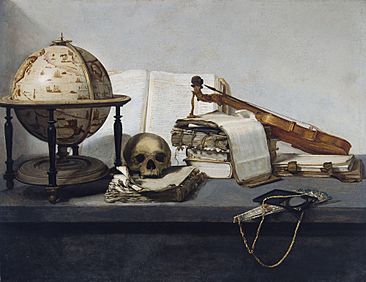Jan Davidsz. de Heem facts for kids
Jan Davidsz. de Heem was a famous Dutch painter who lived from about 1606 to 1684. He was known for his amazing still life paintings. Still life paintings show objects like flowers, fruit, or other items. He was a very important artist during the Dutch Golden Age and the Flemish Baroque period. He worked in both Utrecht and Antwerp.
Contents
About Jan Davidsz. de Heem's Life

Jan Davidsz. de Heem was born in Utrecht. His first art teacher was his father, David de Heem the Elder. Later, he studied with another artist named Balthasar van der Ast.
Around 1625, Jan moved to Leiden and continued his studies there. In 1635 or 1636, he moved to Antwerp in the Southern Netherlands. There, he joined the Guild of Saint Luke, which was a special club for artists. He became a citizen of Antwerp in 1637.
Jan de Heem was a very talented painter. People loved his work, and he had many requests for new paintings. He was considered one of the best painters of his time and earned a lot of money. One of his paintings, showing Prince William III with flowers and fruit, sold for a very high price. His sons also helped him in his art studio. He would often add his own finishing touches and sign their paintings.
He stayed in Antwerp until 1667, then moved back to Utrecht. He left Utrecht in 1671 because French soldiers were getting close to the city. We don't know exactly when he returned to Antwerp, but records show he died there before April 26, 1684.

Jan de Heem was married twice. With his first wife, Alette van Weede, he had three children. One of them, Cornelis, also became a still life painter. After Alette died in 1643, Jan married Anna Catherina Ruckers in 1644. They had six more children, and one of them, Jan, also became a still life painter.
Besides his sons, Jan de Heem taught many students. Some of his famous students included Alexander Coosemans and Abraham Mignon.
Jan Davidsz. de Heem's Artworks
Jan Davidsz. de Heem was one of the greatest still life painters in the Netherlands. He was amazing at making colors look bright and balanced. He also painted objects very accurately. He could paint all kinds of things, like different flowers, European and tropical fruits, lobsters, oysters, butterflies, and even snails and seashells.
His still life paintings included fruit scenes, flower arrangements, and special types called 'vanitas' still lifes. He is most famous for his fancy and rich still lifes, known as 'pronkstillevens'. Some of his paintings showed a lot of items, while others were just a simple festoon (a string of flowers or leaves) or a small nosegay (a tiny bunch of flowers).
Often, Jan de Heem's paintings had a hidden message or meaning. For example, a snake hidden in the grass or a skull among blooming plants could remind people about life and death. Gold and silver cups in his paintings might suggest that earthly possessions are not forever. Sometimes, he painted religious scenes, like the Madonna, surrounded by garlands of fruit or flowers.
He signed his paintings in different ways. Sometimes he used his initials (J. De Heem f.), or his full first name (IOANNES DE HEEM F.). He sometimes added the year he painted it, especially for his best works.
Where to See Jan Davidsz. de Heem's Paintings
Many of Jan Davidsz. de Heem's paintings are in museums and galleries across Europe. Only about 18 of his more than 100 known paintings have a date on them.
One of his early works, from 1640, shows a fancy tankard, a bottle, a silver cup, and a lemon on a marble table. You can see this painting at the Rijksmuseum in Amsterdam. A similar painting from 1645, which also includes fruit, flowers, and a distant landscape, is at Longford Castle.
A beautiful painting from 1648, showing a chalice (a special cup) in a wreath of flowers, is a masterpiece at the Belvedere in Vienna. In the museum of Berlin, there is a large painting from 1650 of the Madonna surrounded by a wreath. This shows how well de Heem could paint bright and colorful scenes on a big scale.
The Prado Museum in Madrid has a painting called Table from around 1651. The Thyssen-Bornemisza Museum also in Madrid, has Flowers in a Glass Vase with Fruit from about 1665.
At the Alte Pinakothek in Munich, there is a famous painting from 1653. It shows vines mixed with gourds, blackberries, oranges, and peaches, with butterflies and beetles adding life to the scene. The Hermitage Museum in St Petersburg has a painting from 1655. It features a blooming rose tree, strawberries, other fruits, and a marble statue of Pan. You can also find some of his works at the Royal Museums of Fine Arts of Belgium in Brussels.
The De Heem Painting Family
Jan Davidsz. de Heem was the most famous painter in his family, but many other de Heems also painted in similar styles. Sometimes, it's hard to tell their paintings apart!
This family of painters started with Jan Davidsz.'s father, David de Heem the Elder. David also had another son, David Davidsz. de Heem, who was a painter.
Jan Davidsz. de Heem had three sons who became painters: David Janszoon de Heem, Cornelis de Heem, and Jan de Heem. Cornelis de Heem also had a son, David Corneliszoon de Heem, who became a painter. So, painting was a big part of the de Heem family!
|
||||||||||||||||||||||||||||||||||||||||||||||||||||||||||||||||||||||||||||||||||||||||||||||||||||||||||||||||||||||||||||||||||||||||||||||||||||||||||||||||||||||||||||||||||||||||||||||||||||||||||||||||||||||||||||||||||||||||||||||||
| Notes: | ||||||||||||||||||||||||||||||||||||||||||||||||||||||||||||||||||||||||||||||||||||||||||||||||||||||||||||||||||||||||||||||||||||||||||||||||||||||||||||||||||||||||||||||||||||||||||||||||||||||||||||||||||||||||||||||||||||||||||||||||
Gallery
- Jan Davidsz. de Heem 's paintings
-
Flowers in a Vase, once part of the collection of Count Karl von Cobenzl in Brussels, bought by Catherine the Great in 1768. Now in Hermitage Museum
-
Table. Prado Museum, Madrid.
See also
 In Spanish: Jan Davidsz. de Heem para niños
In Spanish: Jan Davidsz. de Heem para niños


